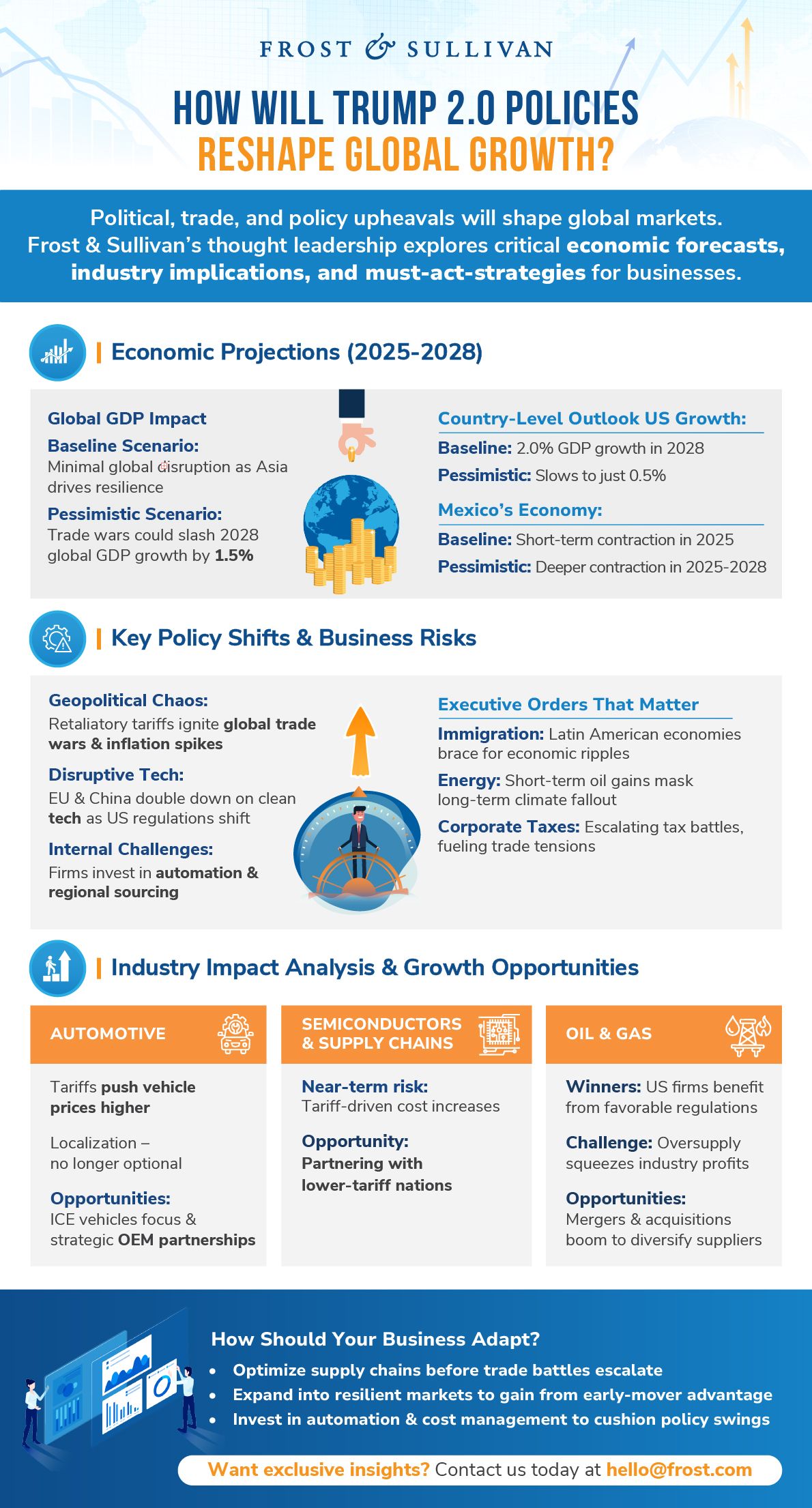With Trump 2.0, the global economy faces a seismic shift. Trade policies, immigration laws, and corporate tax reforms will shake-up economic momentum, affecting global supply chains, industry growth, and market stability.
Frost & Sullivan’s latest macroeconomic thought leadership explores how escalating tariffs, regulatory overhauls, and geopolitical shifts could define the global economic landscape between 2025 and 2028.
Let’s dive into the key forecasts and strategic imperatives businesses must consider in this evolving era to outmaneuver uncertainty.
Want to stay ahead of policy-driven disruptions?

US Policy Shifts: Potential Scenarios & Economic Impact
- Global GDP Growth: A Divided Outlook
- Baseline Scenario: Asia-led growth keeps global momentum intact.
- Pessimistic Scenario: Prolonged trade wars could slash global GDP growth by up to 1.5% by 2028.
- United States: GDP could plunge to just 0.5% in a worst-case scenario
- Mexico & Canada: Trade and immigration restrictions could trigger multi-quarter recessions.
- Industry Impact: Winners & Losers Under Trump 2.0
- Automotive: Rising Costs & Localization Strategies
- Higher metal import tariffs to drive up vehicle prices, straining consumer demand.
- Growth Opportunity: ICE vehicle production revival as manufacturers pivot from electric vehicle (EV) investments.
- Localization: local/regional partnership resurgence to mitigate supply chain risks and for competitive auto loan plans.
- Oil & Gas: Regulatory Benefits, Amidst Margin Pressures
- Short-term regulatory advantages could boost US oil and gas firms, but global oversupply threatens profitability.
- Growth Strategy: Strategic supplier diversification from low-tariff regions like Europe, South America, and Asia can help manage rising costs.
- Mergers & Acquisitions (M&A): Acquiring foreign suppliers in stable markets can ensure resource access and minimize trade war risks.
- Semiconductors: Navigating Tariff-Led Quagmire
- Targeted tariffs on tech components – a pessimistic case – could choke profit margins of US semiconductor firms
- Growth Strategy: Expanding manufacturing hubs in India, Vietnam, and Mexico could provide tariff relief and supply chain resilience.
- Automotive: Rising Costs & Localization Strategies
Strategic Business Imperatives for 2025-2028
- Geopolitical & Trade Chaos: How to Stay Competitive
- Real-time supply chain monitoring will be critical to managing disruptions.
- Localized production & sourcing will no longer be an option—it’s an economic necessity.
- Tech & Sustainability: The New Global Battleground
- The EU and China are racing ahead in clean tech.
- US clean energy firms may face tougher regulations, requiring product diversification and market expansion in Asia and Europe.
- Business Model Adjustments: Strategies for Profitability
- Companies will shift sourcing to low-tariff regions and invest in automation to cut costs.
- Some businesses may absorb higher costs to stay competitive, while others will rely on premium pricing and localization strategies.
How to Navigate Trump 2.0’s Economic Shifts
With Trump 2.0 bringing new trade wars, policy shifts, and tariff escalations, businesses must adapt their strategies for resilience and long-term growth.
From localizing supply chains to diversifying markets and investing in automation, decision-makers must act now to mitigate risks and seize opportunities.
👉 Want to stay ahead of policy-driven disruptions?



